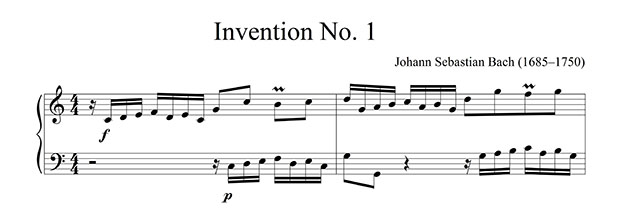
Sometimes I’m so focused on how my notation looks I utilize playback only for proofing. Other times I’m all about fine-tuning the playback. Today I’d like to share one of my favorite keyboard playback tips I use when I’m in a fine-tuning mood.
To join in the fun, open up the following piece, included with Finale:
File > Open Worksheets & Repertoire…> Worksheets & Repertoire > Repertoire > Classical > Piano Keyboard > Bach Invention 1
In the first measure, add the two dynamics I’ve added in the example above.
Upon playback the right hand begins forte, but drops to piano when the left hand starts playing. If you’d prefer that the two staves respond to dynamics and articulations separately, this is easily accomplished in Finale, and it opens the door to more refined playback possibilities. One way to do this is to assign each staff to a separate MIDI channel.
Here’s how:
- From Finale’s Window menu select Score Manager (or use the shortcut Ctrl+K on Windows or COMMAND+K on Mac).
- In the Name column, click the triangle next to [Group 1], which expands to show both staves.
- Finally, on [Staff 2] change the playback channel from 1 to 2. To do so select the “1” listed in the Channel column, type “2,” then hit the Enter or Return key. The result should look like this:

Now when you play the file, the right hand will remain forte when the left hand begins: each staff will respond independently to dynamics. Best of all, this change applies to articulations, hairpins, and pedaling.
If you’d like to see a Finale file that’s already set up with independent piano channels, check this out:
File > Open Worksheets & Repertoire…> Worksheets & Repertoire > Repertoire > Classical > Piano Keyboard > Liszt Consolations no. 3
In this piece you might also notice some “ghost” expressions, which appear on screen, and impact playback, but don’t print. Interested in how to do that? Let me know by clicking on “Comments” below and I’ll share in a subsequent post.